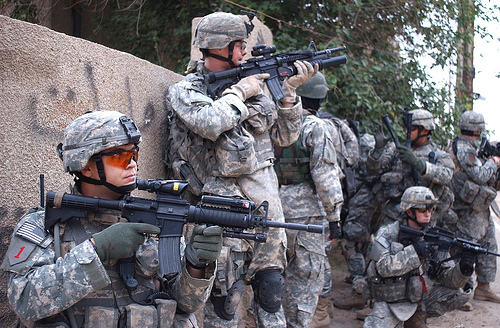
The all-in cost of the all-volunteer force is a ticking time bomb that could explode our defense capabilities if not dealt with responsibly. Unfortunately, the Pentagon does not track the real cost of personnel decisions, making smart reform difficult.
To be sure, they’re aware that manpower costs have reached unsustainable levels. Secretary Panetta has stated that “the escalating growth in personnel costs must be confronted. This is an area of the budget that has grown by nearly 90 percent since 2001” for approximately the same size force. Robert Hale, DoD’s Comptroller, notes that “the cost of pay and benefits has risen more than 87 percent since 2001, 30 percent more than inflation.” Additionally, the Center for Strategic and Budgetary Assessment offered the following sobering commentary in July 2012 on military personnel costs: “Over the past decade, the cost per person in the active duty force increased by 46 percent. If personnel costs continue growing at that rate and the overall defense budget remains flat with inflation, military personnel costs will consume the entire defense budget by 2039.”
What are those costs? Military healthcare and retirement costs alone have increased to about $50 billion and $100 billion a year respectively and these costs are projected to continue their climb. The overall DoD cost of “taking care of people” now consumes more than $250 billion or almost 50 percent of the total defense budget. An additional $200 billion is spent by the Departments of Veterans Affairs, Labor, Education, and Treasury on programs that benefit veterans and their families.
The Reserve Forces Policy Board (RFPB), which I chair, reported earlier this month that senior DoD decision makers do not know, use, or track the fully-burdened and life-cycle costs of their most expensive resource—military personnel—in developing courses of action (and making assessments and decisions on future force mix options. Although the Department requires its contractors to provide fully-burdened and life-cycle cost computations on their invoices, and the Department’s acquisition process requires the same before approving the purchase of major weapon systems, the Board found that the Department does not look at these costs for its Total Force manpower. Instead, they use an incomplete, inconsistently used list of costing factors with no DoD guidance to the Services on how to compute military manpower costs. Thus, major military manpower decisions are uninformed on the real present and future costs.
The RFPB project team conducted quantitative fiscal analysis and met with a wide range of subject matter experts inside and outside of DoD to develop the report. During the development of the cost methodology study, the RFPB project team held more than 100 meetings for substantive discussion and examination of the data. The meetings provided quantitative validation of the relative importance and fully-burdened value of the various cost elements. These elements can be explored individually and in more detail by referring to the report. However, the most telling outcome of the analysis was confirmation of earlier studies that showed that Reserve Component (RC) members cost less than one third that of their Active Component (AC) counterparts when not activated for duty.
In its report, the RFPB felt that addressing all of the specific cost factors associated with Active and Reserve Component members must be compared and included in a consistent manner in order to significantly reduce the current data gap in its cost analyses. In particular, the RFPB found that the DoD is neither complete nor consistent in its consideration of some of the most important cost factors when weighing the relative costs of Active and Reserve Component forces. While the Services generally do consider basic costs associated with AC/RC personnel accounts (like the annual appropriations pay accounts), there are significant costs paid from other accounts (either at the DoD level or by other federal agencies) that are not counted in Active and Reserve Component comparative cost analyses. Current methodologies used in DoD omit a significant portion of the annual costs. Consequently, such analyses fail to reflect the fully-burdened cost to the DoD and other Federal agencies, much less to the American taxpayer. Thus, the RFPB recommended mandatory inclusion of specific cost factors in all future Departmental studies comparing the costs of Active and Reserve Components in order to accurately capture the fully-burdened and life-cycle costs of military manpower.
The RFPB made six recommendations. They are:
1. Establish DoD policy/guidance for computing fully-burdened Military Personnel Costs for the Total Force.
2. Specify all the cost elements that must be included in cost studies.
3. Identify mission support, Treasury contributions, and all other external costs that must be considered.
4. Calculate and report cost element figures annually.
5. Clarify the use of composite rates in studies.
6. Develop a model to calculate and compare life-cycle costs.
Each of the recommendations was explored more fully in the body of the report. However, the primary purpose of the recommendations was to ensure senior DoD leaders receive accurate analysis products that are based on more complete and consistent data. The Board believes that the establishment of a standard costing method for determining individual component costs is essential and foundational when exploring Active and Reserve Component mix and mission alternatives in a budget constrained environment.
Arnold Punaro is an Atlantic Council Board director, chairman of the Reserve Forces Policy Board, and CEO of the Punaro Group.
Photo credit: US Army Flickr
Image: 489832802_dd597bbe5c.jpg
